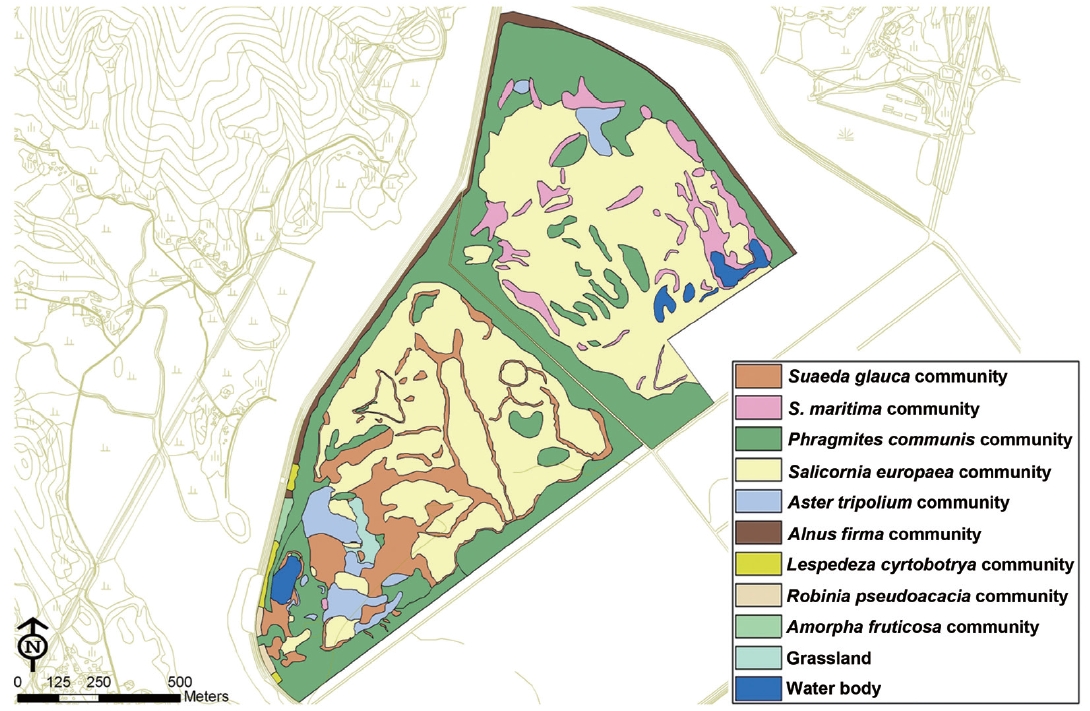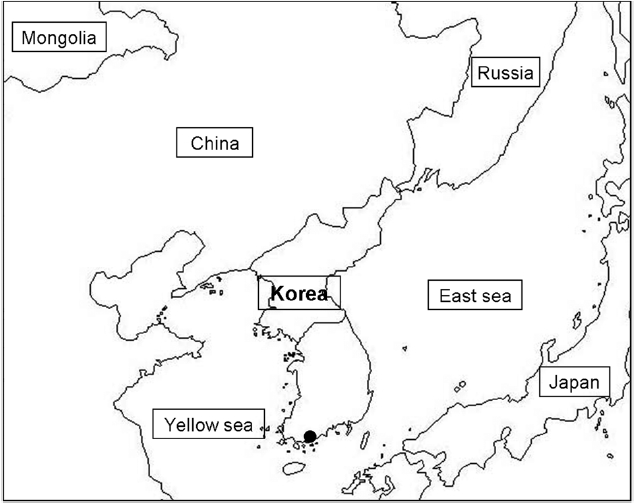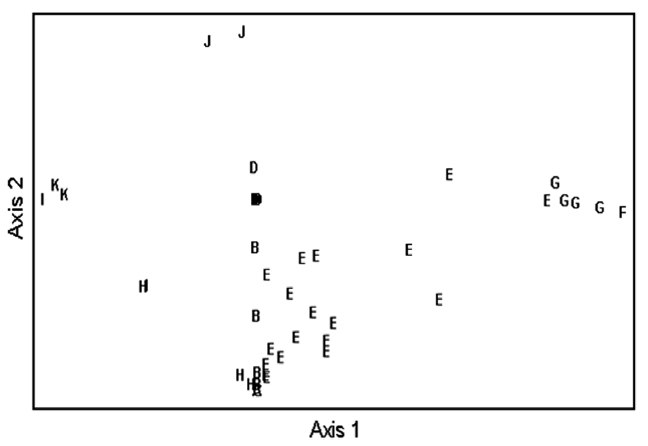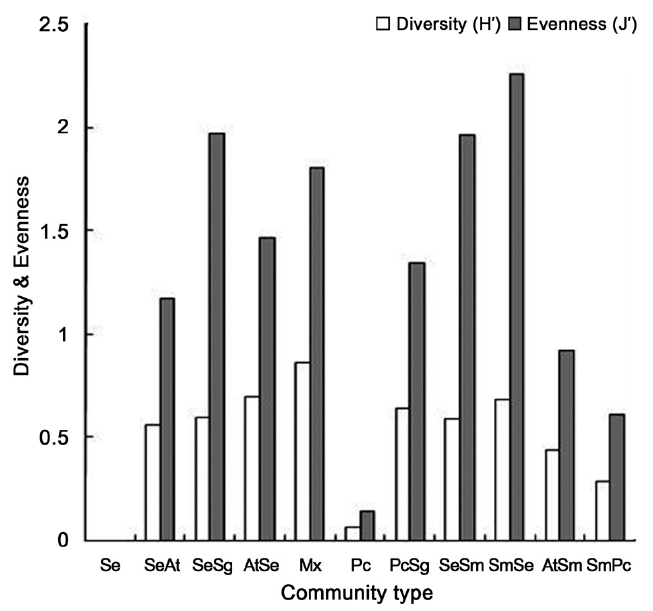



Salt marsh is an important transitional zone among terrestrial, riverine, and marine ecosystems and is a productive habi-tat that interacts extensively with adjacent landscape elements of estuarine and coastal ecosystems. Nowadays, in addi-tion to various human activities, a variety of natural processes induce changes in salt marshes. This study aims to provide background information to restore disturbed salt marshes and to propose their ecological restoration using seed banks. The study area is a prepared area for the Gwangyang Container Port located in the southern Korea. This area was formed by accumulating mud soils dredged from the bottom of the forward sea. This land was created in a serial process of pre-paring the Gwangyang container port and the salt marsh was passively restored by seeds buried in mud soil dredged from seabed. As a result of stand ordination based on vegetation data collected from the land, stands were arranged according to tolerance to salinity in the order of Suaeda maritima, Salicornia europaea, and Phragmites communis communities on the Axis 1. Landscape structure of the projected area was analyzed as well. Edges of the projected area were divided from the marginal waterway by the dike. Four types of vegetation appeared on the dike: Alnus firma plantation, Robinia pseu-doacacia plantation, Lespedeza cyrtobotrya plantation, and grassland. In the more internal areas, two types of vegetation sequences appeared: Aster tripolium community-Suaeda glauca community-Salicornia europaea community sequence and Aster tripolium community-Suaeda maritima community-S. europaea community sequence. Mixed community showed the highest species diversity (H′ = 0.86) and S. europaea community showed the lowest (H′ = 0.0). Evenness is the highest in Mixed community (J′ = 2.26) and the lowest in S. maritime-S. europaea community (J′ = 0.0). Several plant communities were successfully established on the land created by mud soil dredged from the bottom of Gwangyang Bay. Moreover, community diversity in this area approached a similar level with those from other studies involving natural salt marshes. Therefore, restoration effect based on community diversity obtained in our study can be evaluated as a success-ful achievement. In this respect, although most salt marshes in Korea and other places worldwide have been destroyed or disturbed by excessive land use, feasibility of seed bank as a restoration tool is greatly expected.
Salt marshes appear along the edges of shallow seas with soft sediment (Eisma et al. 1998) and are important transitional zones among terrestrial, riverine, and marine ecosystems. Salt marshes include distinctive natural re-sources and maintain key ecosystem processes (Wall et al. 2001). They develop on coastal shores where they are sufficiently protected from wave and tidal energy to al-low sediment suspended in the water column to settle out and accumulate (Chung et al. 2004, Hughes and Paramor 2004, Nottage and Robertson 2005).
Salt marshes develop well in the western and south-ern coasts of Korea because of the big difference between the flow and ebb tides thereby occupying 2.7% of total national area (Han 2008). Salt marshes are ecologically important and productive habitats that interact exten-sively with adjacent landscape elements of estuarine and coastal ecosystems. The most obvious biological charac-teristic is the unique plant communities including many species, which are found only in tidally influenced areas (Nottage and Robertson 2005). Nowadays, however, salt marshes are changing by a variety of natural processes and threatened by human activities (Doody 2001, Nottage and Robertson 2005). In most areas of Korea, salt marshes experience human exploitation such as salterns, farms, reclamations, and so on. A lot of salt marshes have dis-appeared already but the damage is in progress because of the high land use intensity (Ministry of Environment 2006).
Ecological restoration is the process of assisting re-covery of degraded, damaged or destroyed ecosystems (Society for Ecological Restoration International Science & Policy Working Group 2004) and the return to a similar approximation of their original state (National Research Council 1992). The goal of this is to reestablish a complete functional ecosystem (Stanturf et al. 2001).
Seed banks are a group of non-germinated but viable seeds stored in the soil. They can remain dormant for many years to decades until surrounding environments are appropriate for germination (Grime 1989, Simpson et al. 1989). These dormant seed banks can have ecologi-cal and evolutionary influences on actual plants above ground (Kalisz 1990). Therefore, they are recognized as a critical element in management plans of a given ecosys-tem (Cox and Allen 2008). In addition, after destruction or disturbance of an ecosystem, they play an important role in natural regeneration (Grime 1981, Roberts 1981). The value of the seed banks for restoration is different ac-cording to the type and length of disturbance of the site (Middleton 1999).
To date in Korea, most studies on salt marshes have fo-cused on the environmental factors affecting vegetation (Lee and Kim 1988, Lee et al. 2009) such as characteristics and distribution of halophyte (Ihm 1989, Lee 1989, Ihm et al. 1995a, 1995b, 1998a, 1998b, Kim et al. 2005, Han 2008). Therefore, many studies haven’t been done regarding salt marsh restoration, particularly through the use of seed
banks.
This study aims to diagnose feasibility of ecological restoration of artificially disturbed coastal areas. Further, this study aims to evaluate restoration effects based on naturally established species composition and diversity of vegetation in a salt marsh created by seeds buried in the mud soil dredged from the seabed.
The study area is located around the Gwangyang Con-tainer Port, Southern Korea (latitude N 34°54′-N 35°10′ and longitude E 127°31′-E 127°38′). The land of this study area was created by accumulating mud soil dredged from the seabed to ensure water depth in the Gwangyang con-tainer port (Fig. 1). This land was the bare flat in the early days, but it didn’t remain for a long time because of the abundant seeds that were buried in the dredged soil. This study was carried out in the seventh year since the flat was created. The study area at the time of the survey was covered with salt marsh vegetation and thus resembled a typical salt marsh.
This area is surrounded by Gwangyang-si, Suncheon-si, Yeosu-si, Namhae-county, and Hadong-county and belongs to the warm-temperate forest region (Yim and Kira 1975). Plant communities dominating in this region are
[Fig. 2.] A physiognomic vegetation map showing the projected area for the Gwangyang Container Port.

ment 2006). Mean annual precipitation and temperature at Suncheon weather station, which is the closest weath-er station to the study area, were 1,487 mm and 12.5℃, respectively.
Creation of salt marsh
The land of salt marsh of our interest was created by accumulating mud soil dredged from the bottom of the Gwangyang Bay to ensure water depth in the Gwangyang container port. Salt marsh vegetation was restored pas-sively by seeds buried in the mud soil dredged from the seabed.
Vegetation sampling and data analysis
Vegetation survey was carried out in the salt marsh re-stored passively by seeds buried in the mud soil dredged from the seabed. Vegetation map was prepared by in-terpretation of IKONOS satellite image and color aerial photograph, and field check. The vegetation map was constructed with ArcView GIS (Environmental System Research Institute 1996).
Vegetation sampling was conducted from May to Sep-tember, 2007 on 65 plots. Vegetation survey was carried out by recording the cover class of plant species that ap-peared in randomly installed 1 m × 1 m quadrats. Cover data were transformed from the ordinal scale of Braun-Blanquet (1964), and subjected to ordination. Differences in species composition were analyzed with detrended correspondence analysis (Hill 1979) by using PC-Ord 4 program (McCune and Mefford 1999). Species diversity was compared by Shannon-Wiener (Magurran 2004) and evenness (Pielou 1966) indices.
Landscape structure of the projected area and its sur-rounding areas are depicted in Fig. 2. The edges of the projected area were divided from the marginal water-way by the dike. Vegetation was introduced on the dike and formed a hedgerow. This hedgerow was constructed around the projected area except the southern road side. Four types of vegetation appeared on the dike:
and
Stand ordination based on vegetation data was car-ried out in order to compare species composition among plant communities established in artificially constructed salt marshes around the Gwangyang Container Port (Fig. 3). The eigen values of axes 1 and 2 were 0.813 and 0.386, respectively. According to tolerance to salinity, stands were arranged in the order of
>
Species diversity and evenness
Shannon-Wiener and evenness indices were com-pared among plant communities (Fig. 4). Mixed commu-nity showed the highest species diversity (H′ = 0.86) and
>
Comparison of vegetation types
In the previous studies on salt marshes in Korea, Ihm (1989), Lee (1989), Ihm et al. (1998a), and Han (2008) clas-sified fourteen, eight, nine, and six halophyte communi-ties, respectively. Plant communities that they reported were
>
Restoration of salt marshes using seed banks
Bradshaw (1984) suggested three methods for eco-system restoration. First is a passive restoration such as natural recovery. Second is implementing minimum in-tervention to accelerate succession and third is active in-tervention such as sowing seeds, planting trees and using seed banks. In general, the success of salt marshes resto-ration depends on the three factors (Wolters and Bakker 2002), namely the seed banks (Willems and Bik 1998), the presence of species pool (Morton and Law 1997, Zobel 1997, Zobel et al. 1998), and the ability of species to dis-perse (Willson and Traveset 2000, White et al. 2004). It is believed that even if halophytes have disappeared, their seeds may be buried in the soil seed bank. Consequently, they can germinate when the surrounding environment becomes appropriate for growth (Fenner 1985). Recently, studies on active restoration using seed banks and the potential contribution of seed banks for restoration have been gradually increasing (Augusto et al. 2001, Richter and Stromberg 2005, Roovers et al. 2006, Koh 2007, Lee 2007, Zhan et al. 2007, Lee et al. 2008).
Salt marshes are one of the most disturbed places ex-periencing both natural and anthropogenic disturbances (Wang et al. 2009). Seed banks are very useful for recovery of annual plants after disturbances (Baskin and Baskin 1980, Lee et al. 2008) and for the design of restoration projects (Richter and Stromberg 2005). Dormant seeds have significant ecological and evolutionary influences on plant population and community dynamics (Kalisz 1990). A few studies have mentioned that most seeds in salt marshes are transient and short longevity (Thomp-son et al. 1997, Wolters and Bakker 2002). However, sever-al plant communities were established successfully from soils dredged from the bottom of Gwangyang Bay even though the original purpose of this work was not restora-tion. Moreover, community diversity is similar to the re-sults of other studies. Since there is a great number of salt marshes in Korea and other places worldwide which have been destroyed or disturbed by excessive land use, the use of seed banks as a restoration tool is expected to increase. In addition, it would be applicable to restore landfill front in the reclaimed area such as Saemangeum. In fact, case studies executed in the United States and Netherlands showed that soil seed banks contributed significantly to re-establishment of salt-marsh communities (Turner et al. 1988, Toth 1996, Bakker et al. 2002).



